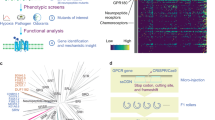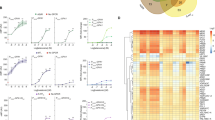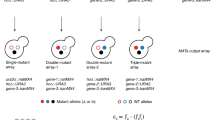Abstract
We describe genetic screens in Saccharomyces cerevisiae designed to identify mammalian nonreceptor modulators of G-protein signaling pathways. Strains lacking a pheromone-responsive G-protein coupled receptor and expressing a mammalian-yeast Gα hybrid protein were made conditional for growth upon either pheromone pathway activation (activator screen) or pheromone pathway inactivation (inhibitor screen). Mammalian cDNAs that conferred plasmid-dependent growth under restrictive conditions were identified. One of the cDNAs identified from the activator screen, a human Ras-related G protein that we term AGS1 (for activator of G-protein signaling), appears to function by facilitating guanosine triphosphate (GTP) exchange on the heterotrimeric Gα. A cDNA product identified from the inhibitor screen encodes a previously identified regulator of G-protein signaling, human RGS5.
This is a preview of subscription content, access via your institution
Access options
Subscribe to this journal
Receive 12 print issues and online access
$209.00 per year
only $17.42 per issue
Buy this article
- Purchase on Springer Link
- Instant access to full article PDF
Prices may be subject to local taxes which are calculated during checkout




Similar content being viewed by others
References
Spence, P. Obtaining value from the human genome: a challenge for the pharmaceutical industry. Drug Disc. Today 3, 179– 188 (1998).
Simonsen, H. & Lodish, H.F. Cloning by function: expression cloning in mammalian cells. Trends Pharmacol. Sci. 15, 437–441 (1994).
Evans, M.J., Carlton, M.B. & Russ, A.P. Gene trapping and functional genomics. Trends Genet. 13, 370–374 (1997).
Hicks, G.G. et al. Functional genomics in mice by tagged sequence mutagenesis. Nat. Genet. 16, 338–344 ( 1997).
Whitney, M. et al. A genome-wide functional assay of signal transduction in living mammalian cells. Nat. Biotechnol. 16, 1329– 1333 (1998).
Khazak, V., Sadhale, P.P., Woychik, N.A., Brent, R. & Golemis, E.A. Human RNA polymerase II subunit hsRPB7 functions in yeast and influences stress survival and cell morphology. Mol. Cell. Biol. 6, 759– 775 (1995).
Law, S.F. et al. Human enhancer of filamentation 1, a novel p130cas-like docking protein, associates with focal adhesion kinase and induces pseudohyphal growth in Saccharomyces cerevisiae. Mol. Cell. Biol. 16, 3327 –3337 (1996).
Kurjan, J. The pheromone response pathway in Saccharomyces cerevisiae. Annu. Rev. Genet. 27, 147–179 (1993).
Bardwell, L., Cook, J.G., Inouye, C.J. & Thorner, J. Signal propagation and regulation in the mating pheromone response pathway of the yeast Saccharomyces cerevisiae. Dev. Biol. 166, 363– 379 (1994).
Chang, F. & Herskowitz, I. Identification of a gene necessary for cell cycle arrest by a negative growth factor of yeast: FAR1 is an inhibitor of a G1 cyclin, CLN2. Cell 63, 999–1011 (1990).
Peter, M. & Herskowitz, I. Direct inhibition of the yeast cyclin-dependent kinase Cdc28-Cln by Far1. Science 265, 1228–1231 (1994).
King, K., Dohlman, H.G., Thorner, J., Caron, M.G. & Lefkowitz, R.J. Control of yeast mating signal transduction by a mammalian β2-adrenergic receptor and G s α subunit. Science 250, 121 –123 (1990).
Stevenson, B.J., Rhodes, N., Errede, B. & Sprague, G.F. Constitutive mutants of the protein kinase STE11 activate the yeast pheromone response pathway in the absence of the G protein. Genes Dev. 6, 1293–1304 (1992).
Price, L.A., Kajkowski, E.M., Hadcock, J.R., Ozenberger, B.A. & Pausch, M.H. Functional coupling of a mammalian somatostatin receptor to the yeast pheromone response pathway. Mol. Cell. Biol. 15, 6188– 6195 (1995).
Manfredi, J.P. et al. Yeast α mating factor structure-activity relationship derived from genetically selected peptide agonists and antagonists of Ste2p. Mol. Cell. Biol. 16, 4700–4709 (1996).
Stevenson, B.J. et al. Mutation of RGA1, which encodes a putative GTPase-activating protein for the polarity-establishment protein Cdc42p, activates the pheromone-response pathway in the yeast Saccharomyces cerevisiae. Genes Dev. 9, 2949–2963 ( 1995).
Klein, C. et al. Identification of surrogate agonists for the human FPRL-1 receptor by autocrine selection in yeast. Nat. Biotechnol. 16, 1334–1337 (1998).
Beals, C.R., Wilson, C.B. & Perlmutter, R.M. A small multigene family encodes Gi signal-transduction proteins. Proc. Natl. Acad. Sci. USA 84, 7886–7890 (1987).
Sato, M., Ribas, C., Hildebrandt, J.D. & Lanier, S.M. Characterization of a G protein activator in the neuroblastoma glioma cell hybrid NG108-15. J. Biol. Chem. 271, 30052 –30060 (1996).
Schneider, J.C. & Guarente, L. Vectors for expression of cloned genes in yeast: regulation, overproduction, and underproduction. Methods Enzymol. 194, 373– 388 (1991).
Kemppainen, R.J. & Behrend, E.N. Dexamethasone rapidly induces a novel Ras superfamily member-related gene in AtT-20 cells. J. Biol. Chem. 273, 3129– 3131 (1998).
Lee, E., Taussig, R. & Gilman, A.G. The G226A mutant of Gsα highlights the requirement for dissociation of G protein subunits. J. Biol. Chem. 267, 1212–1218 ( 1992).
Berman, D.M., Wilkie, T.M. & Gilman, A.G. GAIP and RGS4 are GTPase activating proteins for the Gi subfamily of G protein α subunits. Cell 86 , 445–452 (1996).
Valencia, A., Chardin, P., Wittinghofer, A. & Sander, C. The ras protein family: evolutionary tree and role of conserved amino acids. Biochemistry 30, 4637– 4648 (1991).
Sikorski, R.S. & Boeke, J.D. In vitro mutagenesis and plasmid shuffling: from cloned gene to mutant yeast. Methods Enzymol. 194, 302–318 ( 1991).
Schena, M., Picard, D. & Yamamoto, K.R. Vectors for constitutive and inducible gene expression in yeast. Methods Enzymol. 194, 389– 398 (1991).
Chen, C., Zheng, B., Han, J. & Lin, S.C. Characterization of a novel mammalian RGS protein that binds to G alpha proteins and inhibits pheromone signaling in yeast. J. Biol. Chem. 272, 8679–8685 (1997).
Sambrook, J., Fritsch, E.F. & Maniatis, T. in Molecular cloning: a laboratory manual, 2nd edn (Cold Spring Harbor Laboratory Press, New York; 1989).
Ito, H., Fukuda, Y., Murata, K. & Kimora, A. Transformation of intact yeast cells treated with alkali cations. J. Bacteriol. 153, 163–168 ( 1983).
Sapperstein, S., Berkower, C. & Michaelis, S. Nucleotide sequence of the yeast STE14 gene, which encodes farnesylcysteine carboxylmethyltransferase, and demonstration of its essential role in a-factor export. Mol. Cell. Biol. 14, 1438–1449 (1994).
Rothstein, R. Targeting, disruption, replacement, and allele rescue: integrative DNA transformation in yeast. Methods Enzymol. 194, 281– 302 (1991).
Boeke, J.D., Trueheart, J., Natsoulis, G. & Fink, G.R. 5-Fluoroorotic acid as a selective agent in yeast molecular genetics. Methods Enzymol. 154, 164–195 (1987).
Dietzel, C. & Kurjan, J. The yeast SCG1 gene: a Gα-like protein implicated in the a- and α-factor response pathway. Cell 50, 1001–1010 ( 1987).
Sikorski, R.S. & Hieter, P. A system of shuttle vectors and yeast host strains designed for efficient manipulation of DNA in Saccharomyces cerevisiae. Genetics 122, 19–27 (1989).
Fowlkes, D.M. et al. Yeast cells engineered to produce pheromone system protein surrogates, and uses thereof. Patent no. 5,789,184 (1998).
Broach, J.R., Li, Y.Y., Wu, L.C.C. & Jayarum, M. in Experimental manipulation of gene expression (ed. Inouye, M.) (Academic Press, New York; 1983).
Strathern, J.N. & Higgins, D.R. Recovery of plasmids from yeast into Escherichia coli: shuttle vectors. Methods Enzymol. 194, 319–329 (1991).
Stueland, C.S., Lew, D.J., Cismowski, M.J. & Reed, S.I. Full activation of p34CDC28 histone H1 kinase activity is unable to promote entry into mitosis in checkpoint-arrested cells of the yeast Saccharomyces cerevisiae. Mol. Cell. Biol. 13, 3744–3755 (1993).
Acknowledgements
We thank Drs. Elliott Ross, Henry Bourne, Josh Trueheart, and Ben Benton for helpful discussions and comments, Gary Meissner, Ralph Vaccaro, and Jin Xie for their technical assistance, and Drs. George Sprague, Susan Michaelis, Roger Perlmuter, Mel Simon, Janet Kurjan, and David Stone for providing materials used in this study. S.M.L. was supported by the National Institutes of Health grant RO1-NS24821. A.T. was a visiting graduate student from the Department of Pharmaceutical Sciences, University of Tokyo, Japan, and was supported in part by a University of Tokyo scholarship.
Author information
Authors and Affiliations
Corresponding author
Rights and permissions
About this article
Cite this article
Cismowski, M., Takesono, A., Ma, C. et al. Genetic screens in yeast to identify mammalian nonreceptor modulators of G-protein signaling. Nat Biotechnol 17, 878–883 (1999). https://doi.org/10.1038/12867
Received:
Accepted:
Issue Date:
DOI: https://doi.org/10.1038/12867
This article is cited by
-
Depletion of GPSM1 enhances ovarian granulosa cell apoptosis via cAMP-PKA-CREB pathway in vitro
Journal of Ovarian Research (2020)
-
Dexras1 is a homeostatic regulator of exercise-dependent proliferation and cell survival in the hippocampal neurogenic niche
Scientific Reports (2018)
-
Overexpression of RASD1 inhibits glioma cell migration/invasion and inactivates the AKT/mTOR signaling pathway
Scientific Reports (2017)
-
Molecular mechanism of Gαi activation by non-GPCR proteins with a Gα-Binding and Activating motif
Nature Communications (2017)
-
Regulation of Airway Inflammation by G-protein Regulatory Motif Peptides of AGS3 protein
Scientific Reports (2016)



